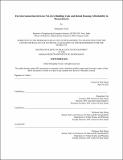The Interconnection between Net-Zero Building Code and Rental Housing Affordability in Massachusetts
Author(s)
Tiwari, Himanshu
DownloadThesis PDF (1.807Mb)
Advisor
Tan, Zhengzhen
Zheng, Siqi
Terms of use
Metadata
Show full item recordAbstract
With the continued focus of policymakers on achieving net-zero targets, there has been an increased focus on decarbonization of the housing markets through net-zero energy building codes such as the new “Stretch Code” introduced in Massachusetts. In a quest to achieve declared targets on the “Environmental” front, the “Social” front sometimes gets sacrificed for instance the incremental cost of net-zero may be passed on to landlords and tenants, thus hurting housing affordability.
The existing literature is unclear about the impact, both in terms of direction and magnitude, of net-zero energy building codes on rental housing affordability, comprising of rents and utility payments. Accordingly, careful consideration is warranted to address the issue. The thesis intends to establish a quantitative relationship between the two by exploring the existing regulatory and market frameworks. The research focuses on resolving the issues by analyzing the Home Energy Rating System (HERS) data in Massachusetts to establish the impact of HERS on housing rents and utility expenses and ultimately on rental housing affordability.
The analysis yields that the new Net-Zero building code in Massachusetts namely DOER’s Straw proposal will have an impact of lowering the utility expenses by an average amount of 0.78% for a medium-sized (1,000 sf to 2,500 sf) duplex to 7.99% for a medium-sized (up to 1,000 sf) low-rise multifamily apartment. Considering the premium for market-rate rental housing, the overall housing costs for renters will increase by 2.48% for a large (greater than 2,500 sf) duplex to 6.20% for a large single-family rental house. The variation in the rental affordability is significant across locations, ages, and sizes of the units. Although the utility expense saving is higher for the low-rise multifamily apartments most exposed to the issue of worsening affordability, the overall housing cost increase is substantial considering the market rent premium associated with adherence to the net-zero building code. For a controlled rent housing unit, the rental affordability as defined by the US Department of Housing and Urban Development (Housing Costs upon Household Income) on average is expected to improve by anywhere between 0.32% to 0.54% whereas, for a market rate unit, the rental affordability on average is expected to reduce significantly by anywhere between 0.72% to 10.22%. The affordability changes differ across sizes and types of houses but more importantly with the changes in income as well.
Considering the findings, any incentive program should follow a differentiated approach of incentivizing the households that are not only more susceptible to worsening rental affordability due to substantial increases in housing costs but also where the household income is unlikely to absorb the increased housing costs.
Date issued
2022-09Department
Massachusetts Institute of Technology. Center for Real Estate. Program in Real Estate Development.Publisher
Massachusetts Institute of Technology